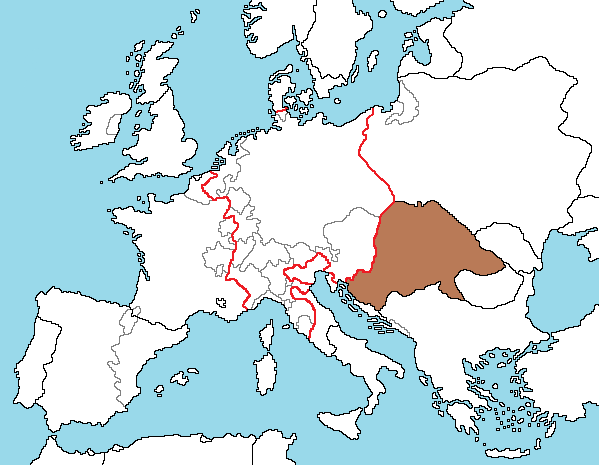THE KINGDOM OF HUNGARY IN 1525

The Kingdom of Hungary in 1525
In 1387 Sigismund of Luxembourg [1368-1437] received the Crown of St Stephen and under this enlightened monarch the medieval Kingdom of Hungary reached its apogee. Sigismund was not only king of Hungary, he was also king of Germany, King of Italy, King of Bohemia and Holy Roman Emperor but despite ruling a medieval superpower, he failed to fulfil his coronation vow to drive the Ottoman Turks out of Eastern Christendom.
After Christian Bulgaria had been added to the Ottomans' Islamic empire, Sigismund crossed the Danube at the head of 90,000 men but the annihilation of his army at the Battle of Nicopolis [1396] exposed the deep divisions in Hungarian society.
The nobility blamed Sigismund for the disaster and when he died childless his empire fell apart. In the west Frederick, head of the increasingly powerful Austrian House of Hapsburg, quickly seized control of the Holy Roman Empire but in Hungary there were decades of civil war.
The two candidates for the Hungarian throne were Sigismund's son-in-lawAlbert, another Hapsburg duke, and Wladyslaw III who was also king of Poland. The former died of plague in 1439, and the latter was killed in battle, but the chaos which followed allowed the warlord John Hunyadi, to seize power as regent for Albert's young son Ladislaus. Hunyadi renewed the war with the Ottomans but he was defeated at the Battle of Varna [1449]. Shortly afterwards Hunyadi resigned the regency and the struggle for the Hungarian succession began again.
Though Ladislaus finally succeeded to the throne in 1453, Hunyadi's two sons rebelled. The elder brother was quickly executed but the younger survived and was crowned Matthias I in 1458. The new king, known to history as Matthias Corvinus (the raven), faced rebellion in every part of his kingdom and he recruited the famous Black Army of mercenaries to crush the unrest. In this he was largely successful but he failed to secure the succession for his illegitimate son and within months of his death in 1490, Hungary was tearing itself apart once more.
The crown passed to a polish prince, Ladislaus Jagiellon, who restored some measure of order, but the always rebellious Hungarian nobles insisted on curbing royal authority as the price of their support. The nobles used their new powers to reduce their serfs to near slavery and the result was a vicious Peasants War that severely weakened the military might of the Hungarian Kingdom.
in 1516 Jagiellon's 10 year old son ascended the throne as Louis II but he inherited a divided and weakened kingdom just as the Ottomans were planning to renew their conquest of Central Europe. The marriage of Louis and his sister to the sister and brother of Charles V, who had become Holy Roman Emperor in 1519, failed to secure Hapsburg support for a new crusade against the Turks and Louis had to face the Ottomans alone.